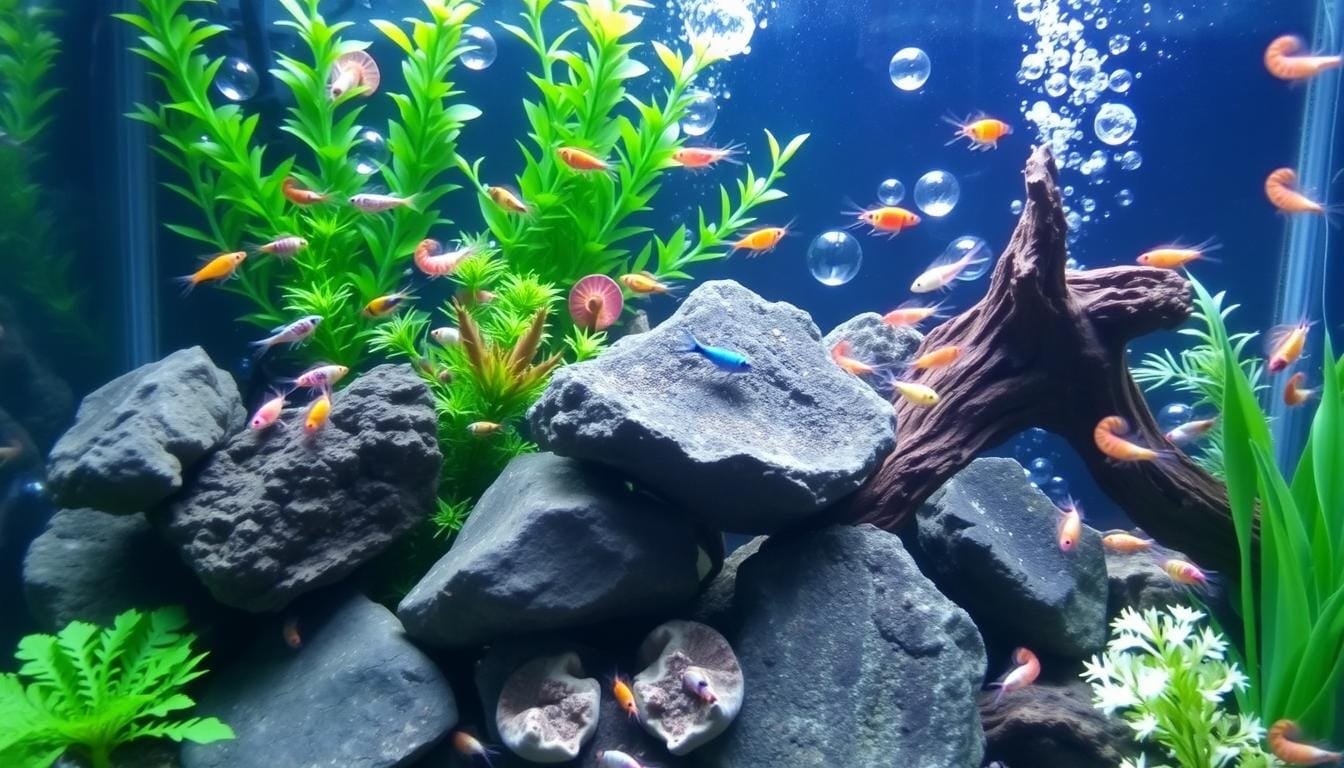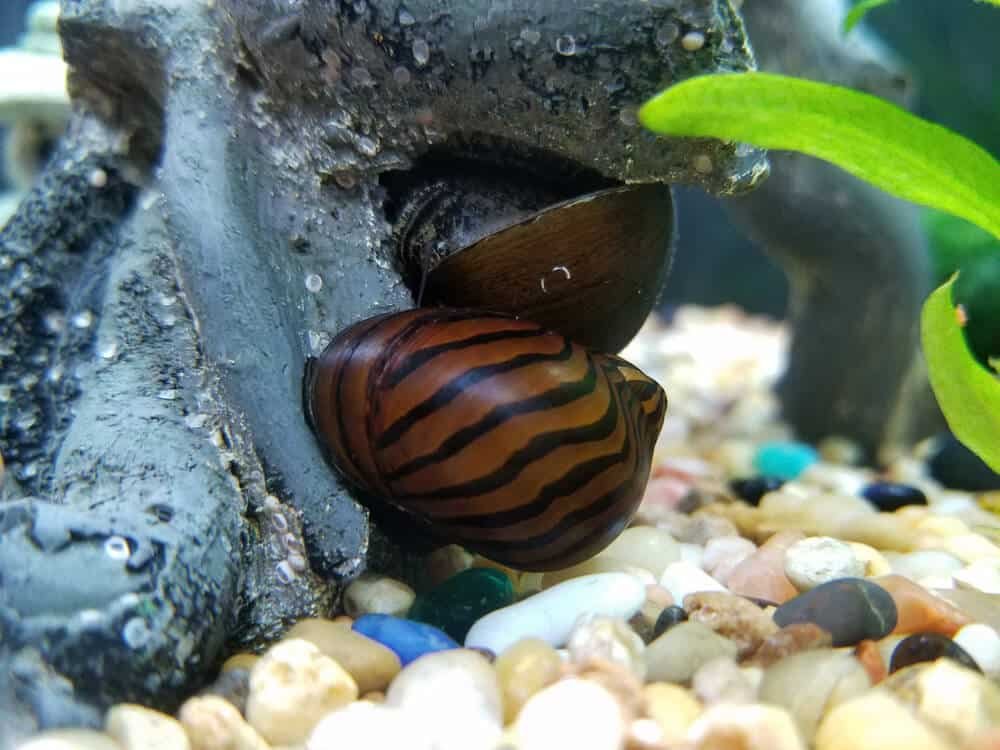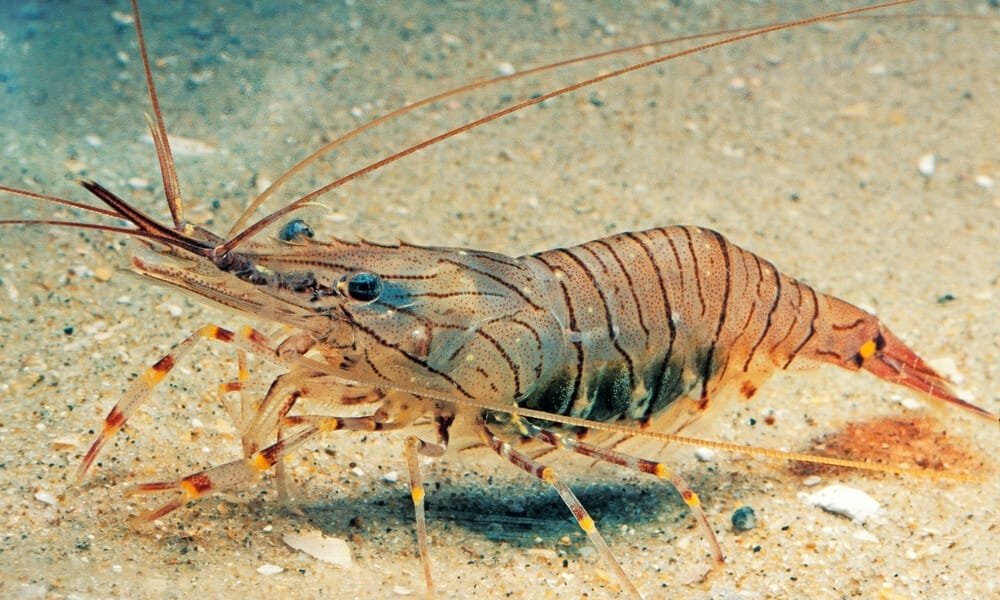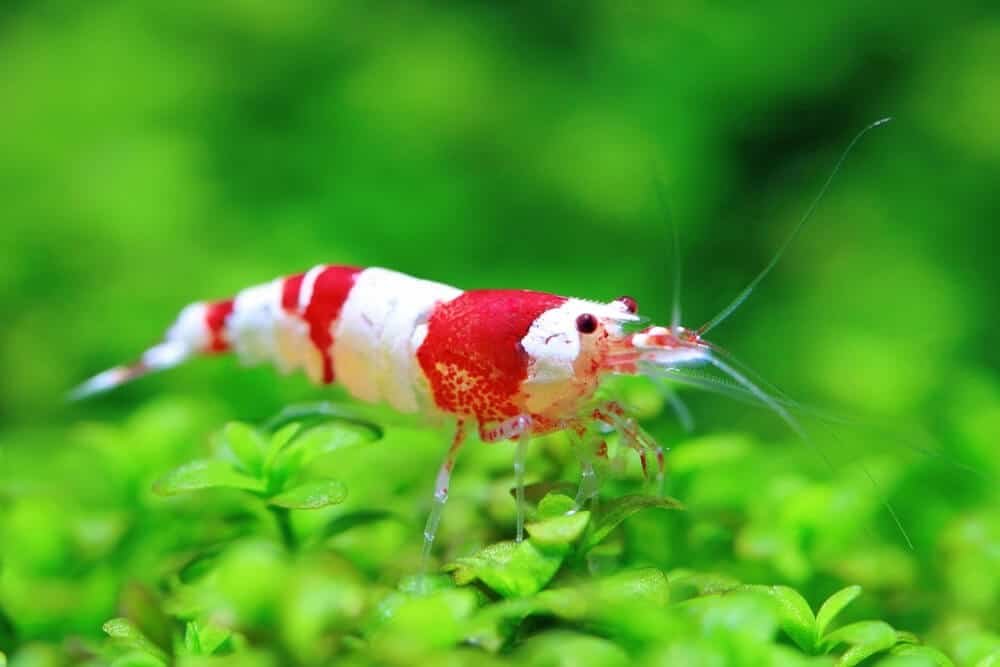Creating a thriving freshwater aquarium with shrimp and snails can be exciting. It’s a fun way to enjoy these fascinating creatures. But it does need careful planning and attention.
Peaceful species are key for a shrimp and snail community tank. Cherry shrimp, or Neocaridina davidi, are great for beginners. They adapt well and are easy to care for.
Cherry shrimp do best in groups of 10 or more. You can keep 10-15 shrimp for every five gallons of water. This helps them thrive and feel safe.
Water quality is crucial for shrimp and snails. They need specific conditions to stay healthy. Regular water changes and good maintenance are important.
Neocaridina shrimp like temperatures between 65-80°F. They prefer a pH of 6.8-7.5 and a General Hardness (GH) of 4-6. These conditions help them grow and reproduce.
Choose peaceful fish as tank mates for your shrimp and snails. Avoid aggressive species that might eat or bother them. This keeps your community tank balanced.
Some snails, like Malaysian Trumpet Snails and Ramshorns, help keep the tank healthy. They clean the substrate and maintain biological balance. But watch their numbers to avoid overpopulation.
Understanding the Basics of Shrimp and Snail Care
Shrimp and snails need specific care in community tanks. Cherry shrimp and Amano shrimp are popular for their adaptability. These species thrive in tropical temperatures between 65-75°F.
Cherry shrimp prefer a pH of 7.0-7.9 and water hardness of 8-14 degrees. Amano shrimp need softer water with pH below 7.0. They also require a GH of 2-5 and KH of 0-2.
Snail Species Compatible with Shrimp
Mystery snails, nerite snails, and Malaysian trumpet snails work well with shrimp. These snails help keep the aquarium clean and healthy. Feed both shrimp and snails once daily with a pinch of fish flakes.
Ideal Water Parameters for Shrimp and Snails
Stable water conditions are crucial for shrimp and snail health. Monitor ammonia, nitrite, and nitrate levels regularly. High ammonia levels can promote growth of beneficial bacteria like Nitrosomonas.
These bacteria convert ammonia to nitrite. Then, Nitrobacter colonies appear to change nitrite into less toxic nitrate.
| Parameter | Neocaridina Shrimp | Caridina Shrimp | Snails |
|---|---|---|---|
| Temperature | 65-75°F | 65-75°F | 65-85°F |
| pH | 7.0-7.9 | <7.0 | 7.0-8.0 |
| GH | 8-14 | 2-5 | 8-12 |
| KH | 3-5 | 0-2 | 3-8 |
Change 10-20% of the tank water weekly to maintain ideal conditions. Test water regularly. Use at least a 5-gallon tank, preferably 10 gallons or larger.
Cycle your tank for 4-6 weeks before adding shrimp and snails. This ensures a safe and stable environment for your new aquatic friends.
Setting Up the Perfect Habitat
The right habitat is key for healthy shrimp and snails. Focus on substrate, plants, hiding spots, filtration, and aeration. These elements ensure a thriving community in your tank.
Choosing the Right Substrate
Substrate affects shrimp and snail comfort and behavior. Sand or fine gravel are great choices. These allow natural burrowing and foraging.
Pick a substrate with comfortable particle size. Avoid sharp edges that could harm delicate appendages. Choose an easy-to-clean option for a healthy tank.
Incorporating Live Plants and Hiding Spots
Live plants are crucial for shrimp and snail habitats. They offer grazing spots, hiding places, and help maintain stable water. Some great plant options include Java moss, Anubias, and Bucephalandra.
These plants provide biofilm growth and sturdy leaves for grazing. Crypts and Vallisneria create dense hiding spots and improve water quality.

Add driftwood, rocks, and shrimp shelters for a diverse environment. These elements enhance the tank’s look and provide territories for your aquatic pets.
Filtration and Aeration Requirements
Good water quality is vital for shrimp and snail health. Proper filtration and aeration are key. Use a sponge filter or hang-on-back filter with a pre-filter sponge.
Ensure the filter has space for beneficial bacteria. This helps maintain stable water parameters. Add an air stone or air-driven sponge filter for proper aeration.
A low-flow air-driven sponge filter is popular due to their small size; however, a fine intake strainer is required for larger filters to prevent shrimplets from being sucked in.
Carefully select substrate, plants, and hiding spots. Ensure proper filtration and aeration. These steps create an ideal habitat for shrimp and snails in your community tank.
Acclimating Shrimp and Snails to Your Community Tank
Acclimation is vital for shrimp and snails in your community tank. It reduces stress and boosts survival rates. The drip acclimation process helps new inhabitants adjust to tank water parameters.
Match water temperatures within ±1°C to avoid shock. Set the drip rate at 1-2 drops per second. The process typically takes 1-2 hours.
Here’s a comparison of acclimation success rates:
| Acclimation Method | Success Rate |
|---|---|
| Drip Acclimation | 90-95% |
| Float and Plop | 70-80% |
| Plop and Drop | 50-60% |
Wait until the acclimation container has 50% bag water and 50% tank water. For extra safety, aim for 25% bag water and 75% tank water. Use a shrimp net to transfer them.
Shrimp are sensitive and can experience shock if acclimated improperly. Snails are tougher and tolerate changes better.
After acclimation, quarantine new shrimp and snails for 2-4 weeks. This helps monitor their health and prevent disease spread to your main tank.
Feeding Your Shrimp and Snails
Shrimp and snails need a balanced diet in a community tank. They’re scavengers, eating algae, biofilm, and leftover food. Extra food ensures they get all necessary nutrients for health and growth.
Best Food Options for Shrimp
Shrimp need variety to thrive. Great food options include specialized shrimp food pellets, algae wafers, and blanched veggies.
Mix these foods to provide essential nutrients and prevent boredom. Remove uneaten veggies after a few hours to keep water clean.
Ideal Diet for Snails
Snails are great algae eaters with mouths designed for rasping surfaces. They benefit from extra food besides tank algae and biofilm.
Good snail foods include snail food pellets, algae wafers, and blanched veggies like spinach and kale.
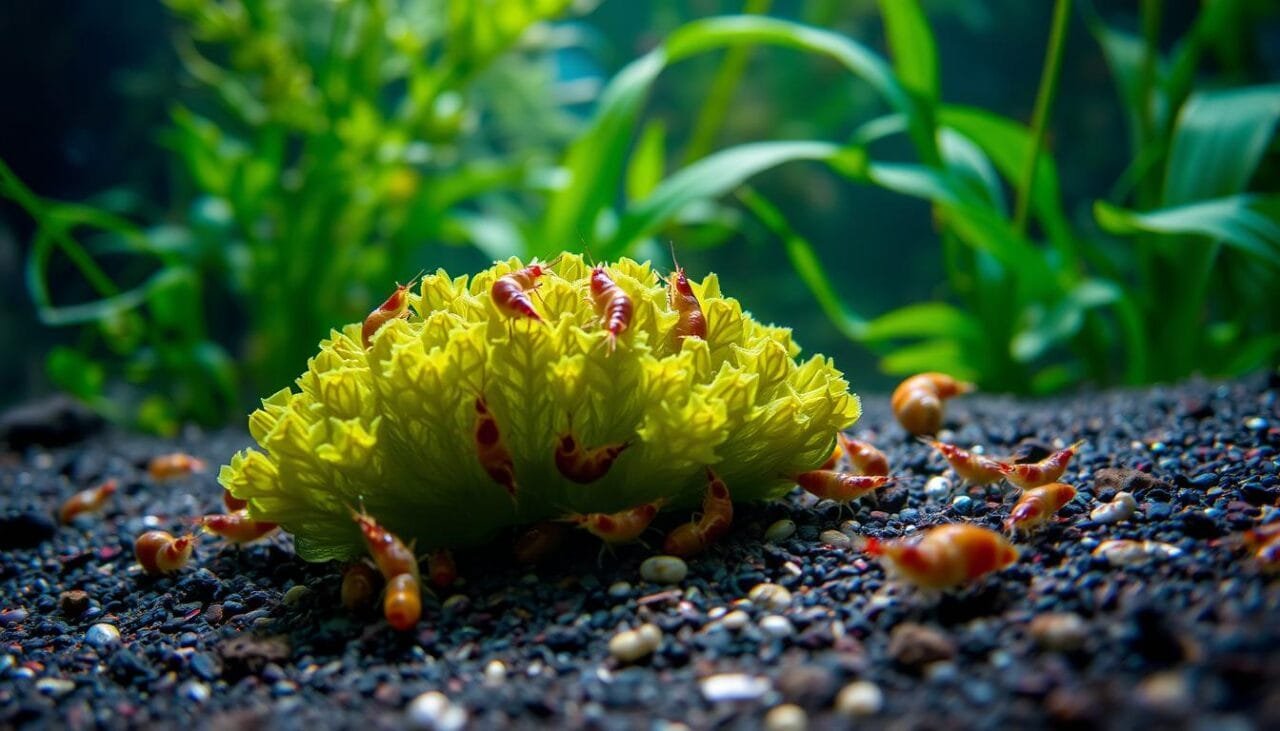
Varied foods ensure snails get a balanced diet and strong shells. Remove uneaten food to keep water clean.
Supplementing with Calcium for Snail Shell Health
Snails need calcium-rich diets for healthy shells. Offer kale and spinach, plus extra calcium supplements.
Cuttlebone is great for calcium. Put it in the tank for snails to eat as needed.
Calcium supplements can be added to water or food. This ensures snails get enough of this key mineral.
| Food Type | Shrimp | Snails |
|---|---|---|
| Specialized Pellets | ✓ | ✓ |
| Algae Wafers | ✓ | ✓ |
| Blanched Vegetables | ✓ | ✓ |
| Calcium Supplements | ✓ | |
| Cuttlebone | ✓ |
Don’t overfeed shrimp and snails, even though they’re great scavengers. Too much food can harm water quality and cause algae growth.
This may lead to snail population issues. Watch how much you feed and adjust to keep your tank balanced.
Keeping Shrimp and Snails in a Community Tank
Creating a thriving community tank with shrimp and snails requires careful planning. Choose compatible tank mates and maintain optimal living conditions. Peaceful fish species and good water quality ensure a harmonious environment.
Choosing Compatible Tank Mates
Select peaceful fish that won’t see shrimp and snails as food. Some great options include small tetras, rasboras, and Corydoras catfish.
These species are unlikely to harm your shrimp and snails. They allow the smaller creatures to thrive in the community tank.
Avoiding Overpopulation and Territorial Disputes
Overstocking can lead to poor water quality and territorial fish behavior. Maintain proper stocking levels based on tank size. Monitor breeding rates of snails and shrimp.
Remove excess snails if needed to control the population. Neocaridina shrimp prefer 10-15 individuals per five gallons of water.
- Maintain appropriate stocking levels based on tank size
- Monitor breeding rates of snails and shrimp
- Remove excess snails if necessary to control population
Monitoring Water Quality and Performing Regular Maintenance
Consistent water quality is vital for shrimp, snails, and fish health. Regular maintenance keeps your tank in top shape.
Weekly water changes and substrate cleaning prevent harmful substance buildup. This includes ammonia and hydrogen sulfide gas, which can harm shrimp and snails.
| Maintenance Task | Frequency | Benefits |
|---|---|---|
| Water changes (10-15%) | Weekly | Removes waste and maintains stable parameters |
| Gravel vacuuming | During water changes | Eliminates debris and uneaten food |
| Water testing | Weekly | Monitors ammonia, nitrite, and nitrate levels |
Freshwater shrimp need a stable environment to thrive, indicating that even minor fluctuations can impact their well-being significantly.
Choose compatible tank mates and avoid overpopulation for a thriving community tank. Maintain excellent water quality through regular care. This approach allows shrimp and snails to flourish alongside peaceful fish species.
Common Health Issues and How to Address Them
Keeping shrimp and snails healthy in a community tank requires vigilance. Early detection and treatment of health issues are crucial. This approach ensures a thriving environment for your invertebrate friends.
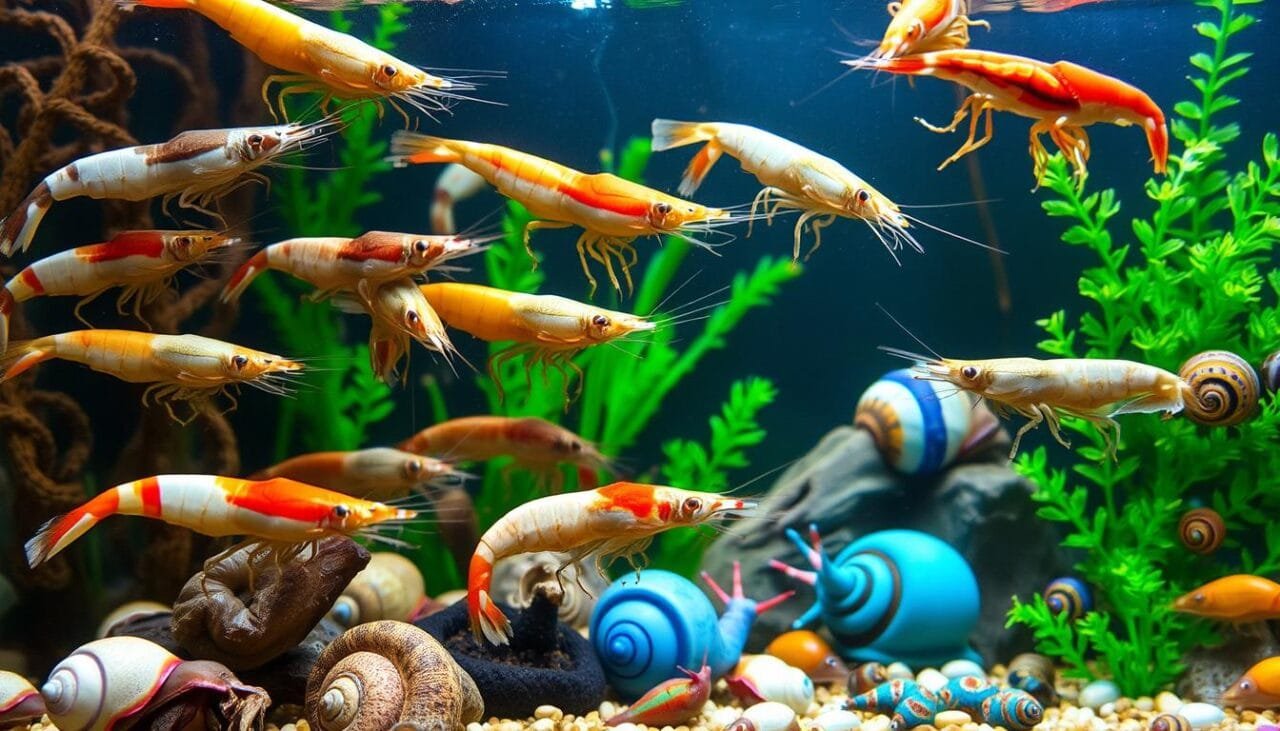
Identifying and Treating Shrimp Diseases
Shrimp can fall prey to various bacterial, fungal, and parasitic infections. Scutariella japonica is a common parasite affecting freshwater shrimp. It can cause breathing and eating problems if not treated.
These parasites are usually 1-2 millimeters long. Treatment involves dissolving 1 tablespoon of aquarium salt in 1 cup of tank water. Dip the infected shrimp in this solution for 30-60 seconds.
Holtodrilus truncates is another threat to shrimp health. It can cause weakness, color loss, and fatal gill damage. Bacterial infections like chitinolytic disease create dark spots on the exoskeleton.
Rust disease treatment uses 1.5 ml of 3% hydrogen peroxide per gallon of water. Apply this for three days in a row. For fungal infections, add 5 ml of API Pimafix per 10 gallons daily for a week.
| Disease | Symptoms | Treatment |
|---|---|---|
| Scutariella japonica | Respiratory and feeding issues | 1 tbsp aquarium salt per 1 cup water for 30-60 seconds |
| Holtodrilus truncates | Weakness, color loss, gill damage | Consult veterinarian for proper treatment |
| Chitinolytic bacterial disease | Dark spot-like lesions on exoskeleton | Prompt treatment to prevent internal spread |
| Rust disease | Rusty spots on exoskeleton | 1.5 ml of 3% hydrogen peroxide per gallon for 3 days |
| Mycosis (fungal infection) | White, fuzzy patches on exoskeleton | 5 ml API Pimafix per 10 gallons daily for 7 days |
Recognizing Signs of Snail Stress or Illness
Freshwater snails can face health issues due to poor water quality or diet. Shell erosion and cracks often signal calcium deficiency or bad water conditions. Stressed or sick snails may become inactive or eat less.
For optimal snail health, provide a balanced diet and stable water chemistry. Regular water changes are also essential. Ideal water parameters include a pH of 6.5-7.5 and temperature between 72-78°F (22-26°C).
Check ammonia, nitrite, and nitrate levels weekly. High levels can harm snails. Offer calcium-rich foods like crushed oyster shells or cuttlebone to prevent shell problems.
Understanding the signs of common diseases can facilitate early diagnosis, thus enabling more effective treatment strategies.
Keep your tank clean and stable. Provide a balanced diet for your aquatic pets. Watch for signs of illness in your shrimp and snails. These steps will help ensure their long-term health and happiness.
Breeding Shrimp and Snails in a Community Setting
Breeding shrimp and snails can be fulfilling when conditions are right. Cherry shrimp and mystery snails often reproduce in tanks. Stable water, hiding spots, and food are key for success.
Creating Optimal Conditions for Shrimp Reproduction
Neocaridina shrimp thrive in groups of 10 or more. This reduces hiding and encourages grazing. A good start is one male for every 4-6 females.
A 20-gallon tank is ideal for breeding Neocaridina shrimp. The max density is 10-15 shrimp per 5 gallons. Maintain stable water conditions for best results.
To create ideal breeding conditions for Neocaridina shrimp, maintain the following water parameters:
| Parameter | Ideal Range |
|---|---|
| Temperature | 70-76°F |
| pH level | 6.8-7.5 |
| General Hardness (GH) | 4-6 |
Shrimp are sensitive to copper and metals in water. High iron can be deadly. Small amounts in plant fertilizers are okay.
Do two 30% water changes weekly. Avoid sudden changes in water conditions. This can cause jumping or death in Neocaridina shrimp.
Encouraging Snail Breeding and Egg-Laying
Mystery snails lay eggs above water. Offer floating plants or egg-laying spots. Ram’s horn snails are loved by dwarf puffers. Trumpet snails are less popular.
Large tanks of 65-120 gallons are best for snail breeding. Snail populations can grow fast in community tanks. This provides food for fish like puffers.
A healthy setup can start with a breeding colony of 1 male to at least 4-6 females for cherry shrimp. From an initial setup of 1 male and 1 female cherry shrimp, approximately 100 shrimp can be produced within six months.
Watch out for overpopulation in your tank. Remove extra shrimp or snails as needed. Proper care leads to successful breeding.
Focus on water quality, hiding spots, and food. With these, you’ll have a thriving community of shrimp and snails.
Maintaining a Balanced Ecosystem
A balanced ecosystem is vital for your shrimp and snail community’s health. Various plant species promote biodiversity and enhance your aquarium’s look. Plants improve water quality, provide oxygen, and serve as natural food sources.
Shrimp and snails are crucial clean-up crew members in your aquarium. They control algae growth and break down organic waste, reducing ammonia spike risks. Regular water changes, avoiding overfeeding, and monitoring parameters support their efforts.
A well-planted tank with diverse inhabitants is ideal. Amano Shrimp excel at eating algae. Nerite Snails help clean without overpopulating. Creating a balanced ecosystem requires careful species selection.
| Parameter | Optimal Range |
|---|---|
| Water Temperature | 72°F – 82°F (22°C – 28°C) |
| pH | 6.8 – 7.5 |
| General Hardness (GH) | 4 – 6 dGH |
| Ammonia | 0 ppm |
| Nitrite | 0 ppm |
| Nitrate | < 20 ppm |
To further support a thriving ecosystem, consider the following tips:
- Perform weekly water changes of at least 30% to prevent waste buildup
- Provide a diet rich in algae, biofilm, and formulated shrimp pellets
- Ensure adequate hiding spaces and plant cover to reduce stress
- Monitor and maintain stable water parameters
- Avoid excessive iron fertilization, as it can negatively impact shrimp health
A well-balanced aquarium ecosystem not only enhances the aesthetic appeal of your tank but also promotes the health and longevity of your shrimp and snail community.
Focus on biodiversity, regular maintenance, and careful monitoring. This approach creates a harmonious environment for your shrimp and snails. They’ll thrive alongside their tank mates in this balanced setup.
Conclusion
Shrimp and snails can enhance your aquarium experience. These peaceful creatures add visual appeal and help maintain a healthy ecosystem. Freshwater shrimp and snails significantly improve water quality by consuming excess food and plant matter.
Maintain ideal water conditions for your shrimp and snails’ well-being. Provide hiding spots with plants and decorations. Use moderate lighting to promote natural behaviors.
Choose compatible tank mates and monitor population levels. This prevents conflicts and keeps the community balanced. With proper care, your shrimp and snails will flourish.
These invertebrates create a stunning aquatic environment. Cherry shrimp, Amano shrimp, and rabbit snails are great options. They work together to make your community tank more vibrant and healthy.
FAQ
What are the best shrimp species for a community tank?
A: Neocaridina davidi (cherry shrimp) and Caridina multidentata (Amano shrimp) are great for community tanks. They adapt easily and eat algae well. These shrimp are simple to care for.
Which snail species are compatible with shrimp in a community tank?
A: Mystery snails, nerite snails, and Malaysian trumpet snails work well with shrimp. They’re peaceful and help keep the tank clean. These snails contribute to a healthy aquarium environment.
What are the ideal water parameters for keeping shrimp and snails?
Shrimp and snails like water between 65-80°F with a pH of 6.8-7.5. They prefer soft water with a GH of 4-6 and lower KH. Stable conditions are key for their health.
How do I set up a suitable habitat for shrimp and snails?
Use sand or fine gravel as substrate. Add live plants like Java moss for grazing and hiding. Include driftwood, rocks, and shrimp shelters to create a natural setting.
Ensure good filtration and aeration to keep water clean. This setup mimics their natural environment and promotes well-being.
What is the proper way to acclimate shrimp and snails to a community tank?
Use the drip acclimation method to slowly introduce them to new water. This reduces stress as they adjust to different parameters. Quarantine new arrivals for 2-4 weeks before adding them to the main tank.
What should I feed my shrimp and snails?
Give shrimp specialized pellets, algae wafers, and blanched vegetables like spinach and zucchini. Snails need a calcium-rich diet for healthy shells. Offer them calcium supplements, cuttlebone, or leafy greens like kale.
How do I choose compatible tank mates for shrimp and snails?
Pick peaceful fish species that won’t eat shrimp or snails. Small tetras, rasboras, and corydoras catfish are good choices. Avoid overcrowding to maintain water quality and prevent fights.
What are common health issues in shrimp and snails, and how can I prevent them?
Shrimp can get bacterial infections, fungal diseases, and white spot syndrome. Snails may suffer from shell problems. Keep water clean and feed a balanced diet to prevent issues.
Quarantine new additions to stop disease spread. Use safe medications for affected shrimp or snails when needed.
Can shrimp and snails breed in a community tank?
Yes, many species like cherry shrimp and mystery snails can breed easily. Maintain stable water and provide hiding spots. Ensure a steady food supply to encourage reproduction.
How do I maintain a balanced ecosystem in my shrimp and snail community tank?
Add various plant species to keep water clean and provide food. Shrimp and snails act as a clean-up crew, eating algae and waste. Do regular water changes and avoid overfeeding.
Monitor key water parameters to keep the environment stable. This approach creates a thriving ecosystem for all inhabitants.
